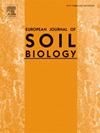Variations in rainfall reduce the contribution of soil fauna to litter decomposition in subtropical mixed forests
IF 3.3
2区 农林科学
Q1 ECOLOGY
引用次数: 0
Abstract
The impacts of global climate change on terrestrial ecosystems are becoming increasingly obvious, particularly changes in rainfall patterns, which directly affect nutrient cycling in forest detrital-based food webs. However, how soil fauna affects litter decomposition and nutrient release under changing rainfall patterns remains to be further studied. We set up litterbag experiments in pure stands of Pinus massoniana (PM) and in mixed forests (PM + Bretschneidera sinensis, PM + Cercidiphyllum japonicum, PM + Taxus wallichiana, and PM + Nageia nagi) in subtropical China to determine how changes in rainfall, such as a 30 % increase or decrease and natural rainfall, affect litter decomposition by soil fauna. Our results indicated that although the effects of increased (promoting effect) and decreased rainfall (inhibiting effect) on the abundance and diversity of soil fauna in mixed litter varied, precipitation changes significantly reduce the contribution of soil fauna to litter decomposition. Compared to natural rainfall quantities, the increase and decrease in rainfall prolonged the time required for 95 % decomposition of litter by 9.93–37.24 % and 32.38–77.07 %, respectively. Soil fauna mitigated the inhibitory effect of reduced rainfall on carbon release from mixed litter, whereas in the case of increased rainfall, the enhanced release of nutrients such as carbon, phosphorus, and potassium from the litter is not attributed to soil fauna. Moreover, the effect of soil fauna on decomposition rates was more obvious in single litter, but rainfall variability had a greater impact on mixed litter. Rainfall changes were an indirect driver of litter decomposition rates, mediating soil fauna and nutrient release. This study demonstrates that litter decomposition is inhibited by changes in rainfall, which also reduces the contribution of soil fauna to litter decomposition. This adds new perspectives and insights for future research on material cycling and decomposer diversity protection in forest systems under climate change.

降雨变化降低了亚热带混交林土壤动物对凋落物分解的贡献
全球气候变化对陆地生态系统的影响日益明显,特别是降雨模式的变化,直接影响以森林碎屑为基础的食物网的养分循环。然而,在降雨模式变化下,土壤动物对凋落物分解和养分释放的影响仍有待进一步研究。在中国亚热带马尾松(PM)纯林分和混交林(PM + Bretschneidera sinensis、PM + Cercidiphyllum japonicum、PM + Taxus wallicana和PM + Nageia nagia)中设置了凋落物袋试验,以确定降雨量变化(如增减30%和自然降雨量)对土壤动物分解凋落物的影响。结果表明,虽然降水增加(促进作用)和减少(抑制作用)对混合凋落物土壤动物丰度和多样性的影响不同,但降水变化显著降低了土壤动物对凋落物分解的贡献。与自然降雨量相比,降雨量的增加和减少使凋落物95%分解所需时间分别延长了9.93 ~ 37.24%和32.38 ~ 77.07%。土壤动物减轻了降雨减少对混合凋落物碳释放的抑制作用,而在降雨增加的情况下,凋落物中碳、磷、钾等养分释放的增加不归因于土壤动物。土壤动物对单一凋落物分解速率的影响更明显,而降雨变率对混合凋落物的影响更大。降雨变化是凋落物分解速率、调节土壤动物和养分释放的间接驱动因素。研究表明,降雨的变化抑制了凋落物的分解,也降低了土壤动物对凋落物分解的贡献。这为未来气候变化下森林系统物质循环和分解者多样性保护的研究提供了新的视角和见解。
本文章由计算机程序翻译,如有差异,请以英文原文为准。
求助全文
约1分钟内获得全文
求助全文
来源期刊

European Journal of Soil Biology
环境科学-生态学
CiteScore
6.90
自引率
0.00%
发文量
51
审稿时长
27 days
期刊介绍:
The European Journal of Soil Biology covers all aspects of soil biology which deal with microbial and faunal ecology and activity in soils, as well as natural ecosystems or biomes connected to ecological interests: biodiversity, biological conservation, adaptation, impact of global changes on soil biodiversity and ecosystem functioning and effects and fate of pollutants as influenced by soil organisms. Different levels in ecosystem structure are taken into account: individuals, populations, communities and ecosystems themselves. At each level, different disciplinary approaches are welcomed: molecular biology, genetics, ecophysiology, ecology, biogeography and landscape ecology.
 求助内容:
求助内容: 应助结果提醒方式:
应助结果提醒方式:


